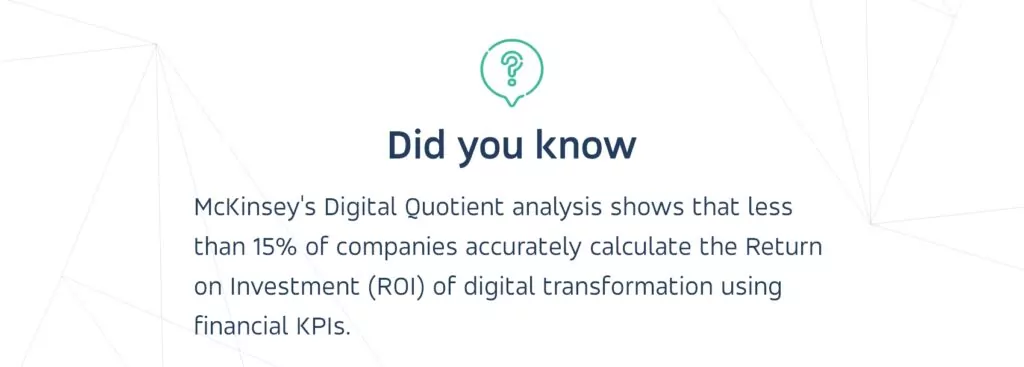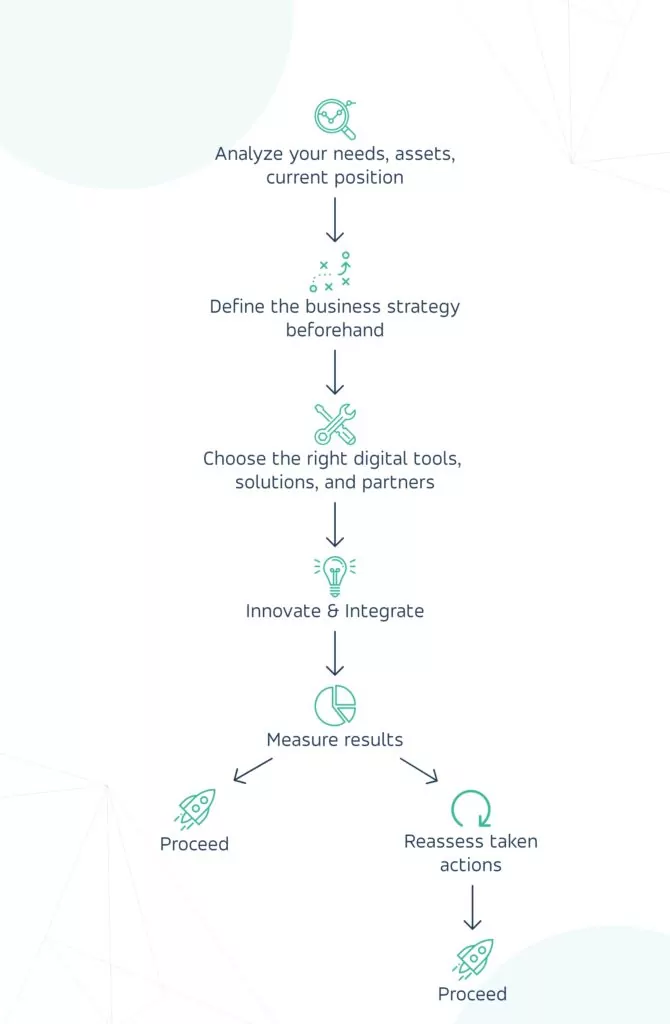Digital transformation is more than just a hip buzzword, it’s common knowledge already. But aside from knowing it’s necessary in many areas, how do we know it followed successfully?
Buckle up, we’ll be your guides.
Digital transformation
Just a small recall on what’s the big deal.

Adopting digital solutions in business should be a part of the strategy for companies wishing to remain competitive in times of Industry 4.0. With the growing digitalization, enterprises that won’t adjust their processes with tech-driven tools will soon risk becoming outdated and staying behind their markets. Just a few years ago digital transformation was among rather sophisticated practices. Nowadays it’s becoming a necessity to stay relevant in the dynamic global market.
How to recognize successful digital transformation?
How to evaluate the adoption of technology leading to better results? Easier said than done. A gut feeling saying we made it is not quite enough, the company needs certain metrics to assess the process and its outcomes.
The Key Performance Indicators (KPI) help understand the ongoing changes and their results, acting as quantifiable measures to understand long-term performance and results of actions taken. The indicators vary depending on the industry and its objectives.
The below examples cover two categories of indicators. Broad business goals are roughly similar for companies regardless of the industry they operate in. The second list presents exemplary business goals broken down into market niches where more specialized, industry-specific indicators determine the success of implemented changes. Defined business goals, similar at the first glance, are achieved through various measures – e.g. cost-saving operations often differ between the manufacturing industry and e-commerce.
Broad business goals
Financial goals
Digital solutions need to contribute to improving revenue, increasing profit margins, and reducing operational costs. Using well-fitted digital tools in daily processes enables significant savings, enabling achieving better financial results.
Customer goals
Overall customer-related goals include taking care of reduced churn, improved retention, and introducing means for more efficient client acquisition. These goals can be achieved through a better understanding of what should the company deliver to satisfy the customer properly, preventing withdrawal from offered services.
Growth goals
Growth is measured in a variety of ways and doesn’t necessarily restrict to revenue only. Companies assess their surge with e.g. units (products, users, contracts), reflecting achievement of objectives. Ongoing business development requires adopting solutions for scaling the operations, answering the needs of a growing customer base.
Employee goals
Applying digital solutions to everyday tasks allows employees to achieve goals, including improving performance with everyday technology. Streamlining the execution of mundane tasks allows employees to focus on more demanding work requiring the human touch, unburdening staff from actions easily ceded to algorithms.
Industry-specific goals
KPIs are unique for each industry and the company itself but can be divided into the main units most vital to a particular business. Solutions implemented as a part of digital transformation should focus on areas requiring the most attention in your operations. You can find below a fraction of which aspects of business can be improved with digital products in various fields:
E-commerce
Conversion rates/abandonment rates
Digital tools that improve customer experience leading to purchasing are necessary for e-commerce to boost the rates. Email marketing, marketing automation, personalization using artificial intelligence, allow companies to stand out in the highly competitive market, winning clients thanks to innovations.
Reduction of operational costs
Implementation of matching tools aimed at e.g. document digitization allows for cutting down the cost of storage (often extensive on-site archives, requiring not only space but also maintaining proper conditions vs storing documents in the cloud). Back-office processes benefit from accelerated search and improved documentation flow.
Transportation
Improved time of delivery
In a striking example of successful adoption of digital tools that impact operations, the delivery company UPS utilized algorithms to optimize their delivery routine which resulted in cost-efficient operations and significant savings.
Traditional services
User experience
Artificial intelligence solutions support the workforce in dealing with customers, improving the experience. AI chatbots replace inconvenient forms and annoying helplines, answering questions in real-time and guiding users further to the operator, in case the provided answer is considered unsatisfactory.
Heavy industry
Reduced downtime
Depending on the source analysis, augmented reality can lower production downtimes by up to 50%, contributing directly to achieving better overall results. Employing digital tools serves a significant role in organizing production and optimizing processes, leading to measurable results.
Predictive maintenance
Machinery requires inspections and service but assessing the upcoming urgent repairs exceeds the potential of the human eye, especially without halting the manufacturing process. Digital solutions arm maintenance technicians with tools to look under the working machine’s hood, indicating where and when service will be necessary to prevent errors.
Safer processes
Digital solutions contribute to improving safety in various areas, especially with computer vision detecting potential threats in the workplace like electrified or loose objects. Employee safety can be verified by adding relatively simple solutions, arming companies with tools to assess whether the whole staff has made it back safely while working in dangerous environments.
Industrial health & safety can be successfully automated using electronic work accidents reports, enabling monitoring and further improvements to avoid future incidents. Another solution improving safety is AI-powered computer vision, employed in e.g. detecting safety measures worn by employees or igniting proximity alerts in case of approaching working machines.

How to measure the ROI of digital transformation?

ROI reflects the efficiency of business investment, paving the way for future changes within the company. Calculating financial profits from digital solutions requires an in-depth recognition of particular steps of the process.
- Identify the area to improve with the adoption of digital technology – as presented above, the scope may cover general or industry-specific subjects.
- Review the specific goals, deciding on which metrics will define improvement – cost reduction, revenue growth, more customers served, better customer experience score, lower error rate.
- Calculate the investment metrics – the necessary infrastructure, services, tools, and related matters.
- Determine success metrics – identify indicators of success, showing improvement in the desired areas, possible to associate with implemented solutions.
- Define a timeframe – decide on a period of time necessary to notice and assess improvements, adjusted to introduced means – different for fast- and slow-paced processes.
What can decrease the chances of successful digital transformation?
Businesses transform to improve – save or earn. If neither of the long-term goals is achieved, it’s highly unlikely to consider the transformation successful. Digital transformation is more than just replacing manual processes with technology, it’s reshaping the ways a company deals with the ever-changing industry-specific challenges.
The percentage of failed digital transformations among companies varies depending on research, but a positive trend can be noticed. While a few years ago even 84% of enterprises failed in transforming their operations digitally, the recent findings show slightly more optimistic numbers (70% as of 2021).
Lack of clear goals
A frequent problem among companies without proper research, who instead of consulting with experts decide ah hoc to try out solutions without planning what their result should be. Sounds like a cliché, but without defined goals, it’s rather difficult to tell whether the company has achieved it.
Lack of clear indicators
Another example of a wild goose chase. Citing the Cheshire Cat from Alice in Wonderland – „If you don’t know where you are going, any road will get you there”. The roads could take you anywhere, even places you didn’t wish to ever land.
Wrong data
Don’t compare apples to oranges while shaping the future of your company. Data used for reporting on the digital transformation needs to be applicable to the process itself, covering comparable periods, results, and costs.
Actions unfit for purposes
A „We need some technology to remain relevant. I like this one, let’s implement it” approach may, with some luck, result in a choice of working solutions that suit the operations, but most likely, unmatched tools won’t give desired results.
Employee resistance
Defiance against the implementation of digital solutions is an often problem, as employees fear becoming redundant once technology takes their jobs. This can be however tackled by ceding mundane tasks to the digital tools and assigning staff more demanding operations, requiring the human touch.
How to assess whether digital transformation will pay off in my company?
Since technology is just a tool helping to achieve chosen goals, its essence may be, paradoxically, considered secondary to the transformation. The main focus should be on the process, leading to understanding the needs and opportunities. Without clearly defined business goals, commitment from the management, and insightful change management, digital transformation may not succeed.
One of the main areas to focus on is the human aspect – leaving staff out of the digitalization process leads to growing concerns among employees, considering technology their competition. Change management requires leaders to execute the transformation in a way securing staff, providing support to employees worried about their future roles remaining after the digital solutions take their jobs. Otherwise, internal resistance may affect the execution of the process, dooming it to fail.
On one hand, we’re mostly analytical minds and won’t advise anyone to follow gut feelings only.

On the other hand, we’re highly convinced that properly applied tech solutions can be a remedy to nearly all business and industrial ills, thus if your intuition tells you to try, try. Just don’t go head first into unknown waters on your own. Try our 1-hour free consultation, and make an informed decision on how to transform your business digitally.
Read more:
Digital transformation in manufacturing
Digital transformation in healthcare
Digital transformation in banking and financial services
Benefits of digital transformation





